Enrollment Trends Report
This report examines enrollment trends for the five-year period beginning in 1998 and ending in 2003, the last year for which complete data were available. The focus is on FIT's associates degree programs, particularly on newly matriculated students in those programs, but data on total enrollments and transfers to baccalaureate programs are also examined. The data were supplied by the Office of Institutional Research and include detailed files of newly matriculated students in 1997, 2000, and 2003, as well as data presentations drawn from the FIT Factbook.
In the aggregate, these data indicate that the profile of FIT students has changed over the last five years and will likely continue to change over the next five years, probably at an accelerated pace. Highlights of this transition include: sharp decreases in the numbers of non-degree students; substantial increases in the number of students enrolled in baccalaureate programs; a pronounced shift from part-time to full-time students; fewer students from the City of New York; fewer students from low-income neighborhoods; and more mobile students seeking a baccalaureate degree who come from greater distances and have greater personal resources.
These changes herald a marked increase in FIT's competitiveness in the market for traditional-age students in both the United States and key countries in Europe and Asia. The result for FIT is a host of new opportunities as well as a number of tough decisions, including: What is the best future for FIT's traditional two-year degree programs? and How should the College go about deciding what its student profile ought to look like? The concomitant challenges will include how and where to recruit new students and how best to use limited financial aid dollars. Our hope is that the discussion and data that follow will prove helpful in making decisions and generating planning goals as FIT goes about the business of choosing what it wants to be.
Admissions Overview
In the five-year period between 1998 and 2003, the number of first-time students applying for the associates degree rose from 7,312 to 8,944a 22% increase. This number reflects an average annual increase of just over 4%. The percentage increase in applicants to Business and Technology programs paralleled the percentage increase in applicants to Art and Design programs. Overall, the Business and Technology applicant pool increased by more than 650, while the larger Art and Design pool increased by almost 1,000.
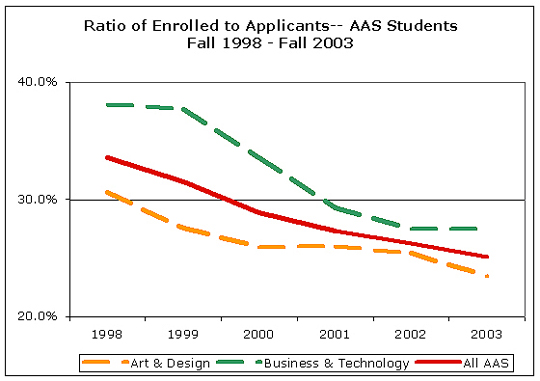
During this period, the proportion of enrolled students to applicants fell substantially. In 1998, approximately one in three FIT applicants ultimately enrolled. In 2003, that proportion was one in four. The decline was dramatic for both Business and Technology and Art and Design. The decline is attributable in large part to the increased selectivity (that is, the falling admit rate) afforded by the steadily increasing applicant pool. The admit rate for Art and Design rose from 42% to 31%, while the admit rate for Business and Technology dropped dramatically from 61% to 40%. For both Art and Design and Business and Technology the yield remained high, with percentages in the low-to-mid 70s for Art and Design and in the high 50s to high 60s for Business and Technology. In both schools, 2003 was the strongest year for both admit rate (lowest) and yield (highest).
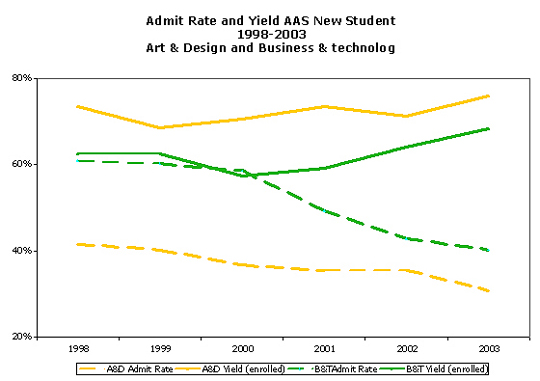
Geographic Shifts
The period of 1997 to 2003 also witnessed a steady shift in the demographics of its entering classes. New York City residents were replaced by students from other parts of the nation. Although New York, the city and state combined, continued to supply the majority of FIT's new associates degree enrollees, its share of enrollment declined sharply while the share from the rest of the nation increased substantially.
The percentage of matriculants from core states, defined as those that provided at least 20 new associates degree matriculants in 2003, rose from 10% in 1997 to 15% in 2003. The nine core states include Pennsylvania, Florida, Maryland, California, Connecticut, Massachusetts, Michigan, Ohio, and Virginia.
New enrollees from other states increased as well, so that nearly one-fourth of all new associates degree students in 2003 were from areas beyond New York, New Jersey, and abroad. The percentage of international students, which had increased between 1997 and 2000, fell below the 1997 level in 2003. This distribution is displayed below in tabular and graphic form.
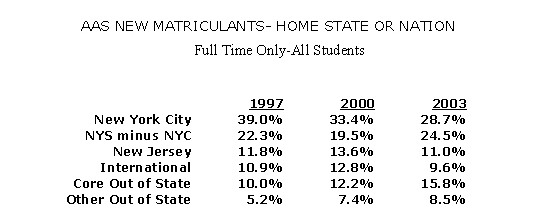
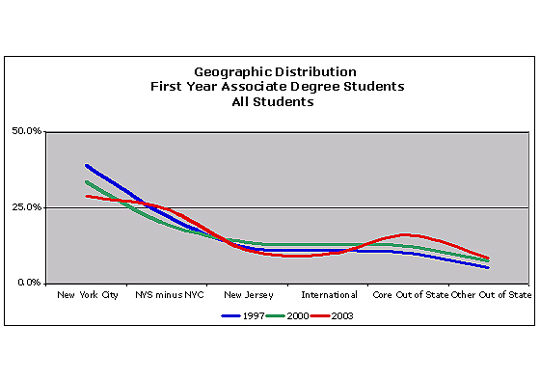
The demographic shift occurred within individual programs as well for both Art and Design and Business and Technology. However, it is in Business and Technology that the changes were most dramatic. While the share of matriculants from the City decreased by 6 percentage points in Art and Design, the decline for Business and Technology was more than 15 percentage points. By 2003, Business and Technology was finding more than 18% of its new associates degree students in the nine core states, and almost 10% in states beyond New York, New Jersey, and the core.
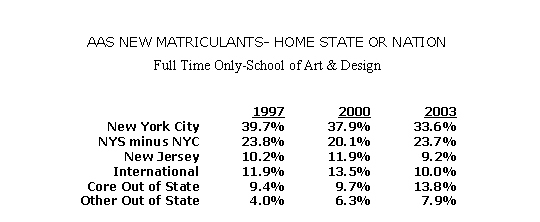
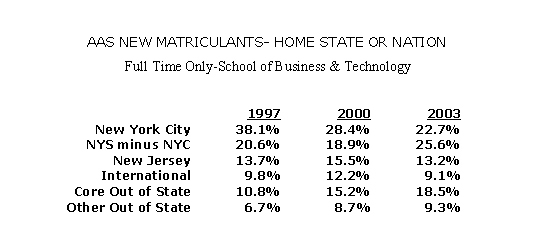
FIT's largest programs appear to be contributing heavily to the demographic shift. In 2003, the FIT program with the largest number of new associates degree matriculants was Fashion Merchandise Management in the School of Business and Technology. This program comprised more than 30% of all new associates degree matriculants. Yet, less than 18% of new students who enrolled in this program in 2003 came from New York City. Fashion Merchandise Management was both FIT's largest associates degree program and the one with the smallest proportion of students from the City.
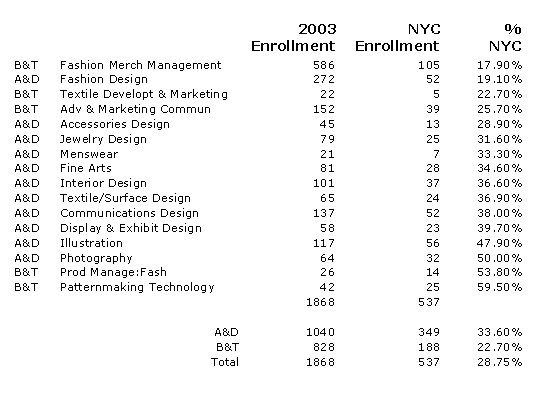
Fashion Design, which is FIT's second largest associates degree program and the largest in the school of Art and Design, was the only other program in which less than 20% of the new associates degree students came from New York City. In contrast, the three programs in which at least half of the new students hailed from the City were: Photography, Production Management: Fashion and Related Industries, and Patternmaking Technology. These programs are relatively small, and together provided only 7% of FIT's new associates degree enrollment in 2003.
Part-time to Full-time
Turning to overall enrollment patterns, we found that from 1997 to 2003 the student body at FIT had shifted from majority part-time to majority full-time (48% full-time in 1997 versus 61% full-time in 2003.) To some extent, this phenomenon is the result of a steady decline in the number of non-degree students. Almost exclusively part-time, the non-degree group included over 4,400 students in 1997, but just over 3,100 in 2003 (source: FIT Factbook). However, even among degree-seeking students, the trend has been toward full-time enrollment. The percentage of degree-seekers attending full-time rose from 77% in 1997 to 84% in 2003.
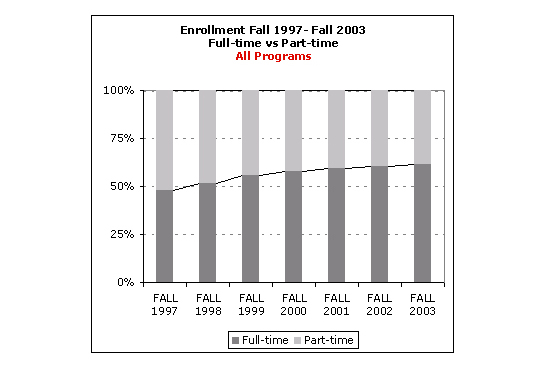
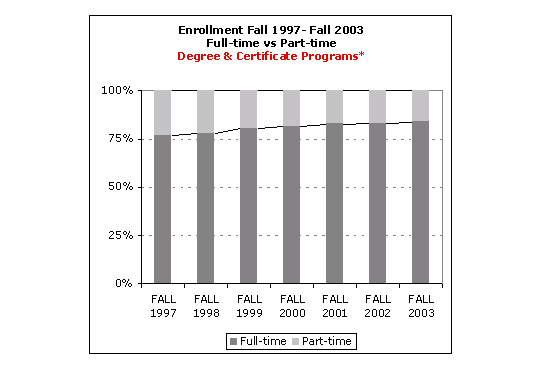
The Rising Importance of Baccalaureate Enrollments
The growth of baccalaureate degree programs has contributed to a significant change in the student body at FIT. From 1997 to 2003 the number of students enrolled in bachelor's degree programs climbed from 1,858 to 2,763 (source: FIT Factbook).
A vast majority of the bachelor's degree enrollment derives from FIT's own associates degree graduates. In 2000, for example, 44% of all associates degree recipients continued to work toward a bachelor's degree at FIT (source: FIT Factbook).
There was, however, great variability in transfer rates according to the students associates degree program. Fewer than 10% of students who received associates degrees in Photography or Menswear continued on for a bachelor's degree, while more than 70% of students in Accessories Design, Communication Design, Display and Exhibit Design, and Advertising and Marketing Communication did so.
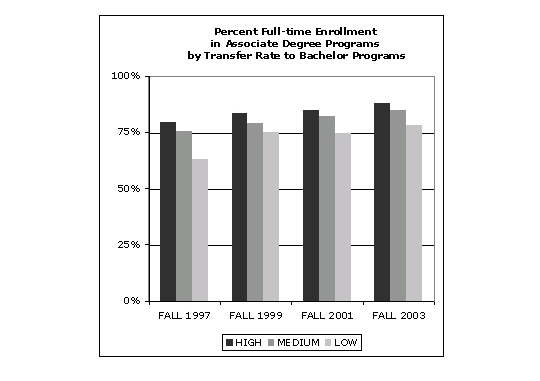
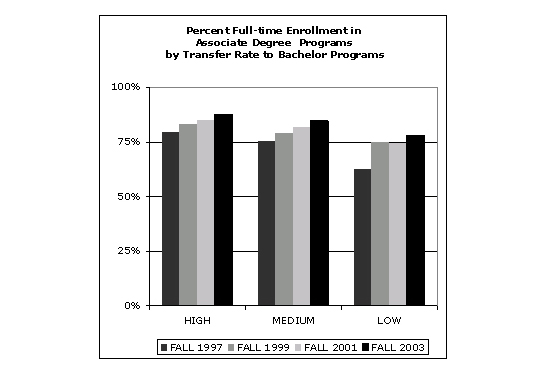
The associates degree programs in which the highest proportion of students (over 50%) were likely to continue on for a bachelor's degree (high transfer) also tended to be those with the highest proportion of full-time enrollment. Those with more modest transfer rates (one-third to one-half of associates degree recipients, or medium transfer) had somewhat higher numbers of part-time students; those with the lowest transfer rates (under one-third, or low transfer) had the smallest proportion of full-time students. And, as was the case with overall enrollment, student matriculation in associates degree programs has shifted toward full-time enrollment in recent years.
Income Bands
To chart the changing financial circumstances of the FIT student body, we conducted a special analysis of income data drawn from the greater New York metropolitan area (including the Connecticut and New Jersey suburbs adjacent to New York City), which has the largest concentration of new associates degree students.
Household income data derived from the 2000 Census was mapped into zip code areas, allowing us to construct a measure of the wealth of the neighborhoods from which the FIT students are drawn. (We understand that the data are averages of median household income and do not reflect the incomes of actual students, but they serve as a rough proxy of the economic circumstances of the students.)
Between 1997 and 2003, there was an observable shift in the distribution of students away from lower income neighborhoods and towards middle-income neighborhoods. In particular, in 2003 a greater proportion of students came from neighborhoods with median household incomes in the $50,000 to $74,999 range than in 1997 or 2000.
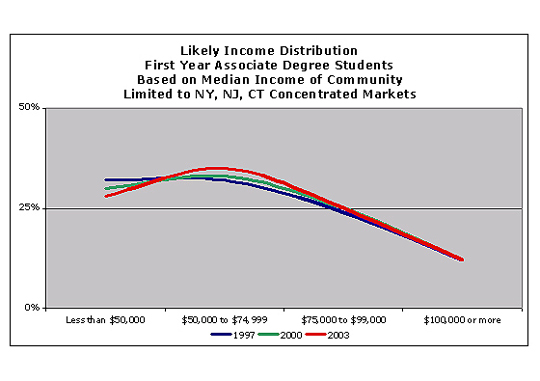
While not as dramatic as the trend in the overall associates degree data, the same finding is nonetheless evident in Art and Design. An additional finding for Business and Technology includes a shift in students from neighborhoods with median household incomes in the $75,000-99,000 and the $50,000-$74,999 range in 2000.
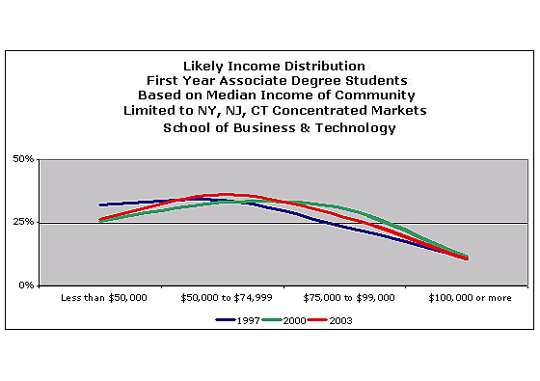
It is not surprising that students who enrolled in low transfer programs—that is, students who generally completed their educations at the associates degree level—tended to be more highly concentrated in lower income neighborhoods. Students who were in high transfer programs, where the majority aim for a bachelor's degree, are by contrast more likely to come from middle-income neighborhoods.
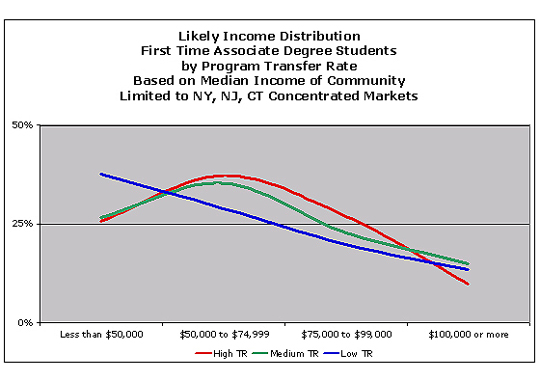
It follows logically, then, that students in low transfer programs more frequently received higher financial aid awards. From the income analysis it is clear that more low transfer students came from lower income neighborhoods and were likely to be in greatest financial need. For the low transfer group, the aid award most commonly fell between $10,000 and $15,000, with a substantial percentage of awards greater than $15,000. In all, almost two-thirds of the low transfer students received aid of at least $10,000. For students in high and medium transfer programs, awards most likely fell between $5.000 and $10,000.
This finding was repeated for students in the School of Art and Design, but with a more dramatic contrast between high transfer students and others. In the high transfer group, only 11% of the students were awarded more than $15,000, while the percentage receiving such awards in the low and medium groups was 30% and 26%, respectively. On the other hand, it is noteworthy that one-quarter of Business and Technology students—the vast majority of whom were enrolled in the high transfer Fashion Merchandise Management program—were awarded financial aid over $15,000.
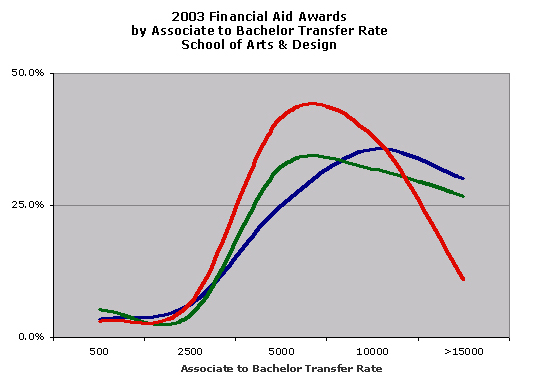
Summary
Several conclusions can be drawn from this analysis. First, if the trends of the last five years were to continue for the next five, the FIT that emerges would be fundamentally different—a more national and extended-regional student body, more students who arrive committed to earning a baccalaureate degree, and more students who matriculate with the means to pay more of their own way. The strength of the admissions profile also indicates that the College could choose a different future, provided it develops a sufficient consensus regarding what that future should look like and invests time and resources in learning to manage its applicant pool. In this respect, FIT is one of the few institutions in the United States that can truly choose what it wants to be.